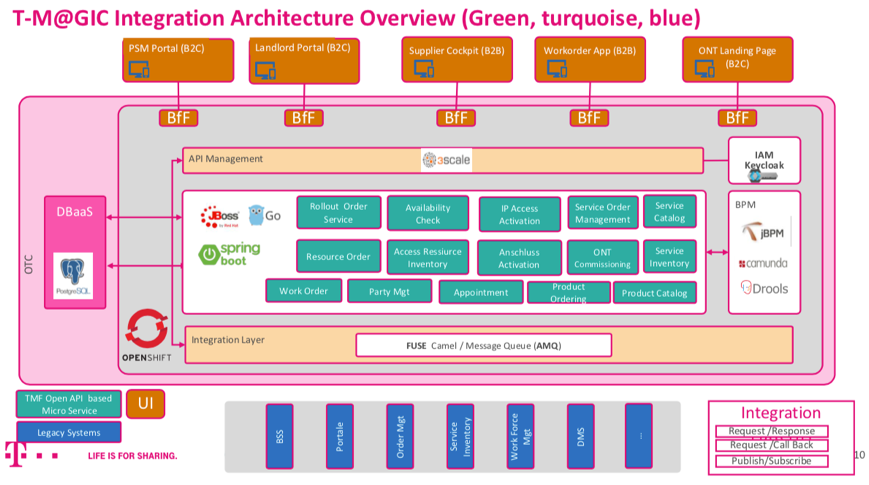As one of the world’s leading integrated telecommunications companies, Deutsche Telekom has an overarching goal: to enable connectivity in society. And providing fast, reliable internet to as many people as possible is one way it’s achieving that goal.
Deutsche Telekom is currently replacing copper cables with fiber-optic lines, including a rapid mass rollout to almost 40 million homes across Germany. Red Hat and our partner Capgemini, a global systems integrator (GSI), are providing the expertise and technology Deutsche Telekom needs to make this initiative possible.
Preparing for a rapid mass rollout
When Deutsche Telekom first began this initiative, it only had rudimentary processes for ordering, installing and provisioning connectivity services. Customers needed to interact with different departments before completing, printing and submitting paper forms.
These processes and the systems supporting them were neither scalable nor suitable for a rapid mass rollout, so Deutsche Telekom decided to transform its Operations and Business Support Systems (OSS/BSS) platform to support the fiber-optics rollout better.
The company integrated an end-to-end solution with help from Red Hat and Capgemini to reduce the number of customer interactions, scale to meet a large number of requests and simplify overall processes. The solution would also need to open the door to new business models with different third-party providers in order to mutualize costs, assure time to market and optimize its market share of Germany’s broadband fiber market.
Working with an experienced GSI partner
After recently completing another strategic project together, Deutsche Telekom reached out to Capgemini to help with this new initiative. As a Red Hat GSI partner, Capgemini works closely with Red Hat to drive digital transformation for leading organizations around the world.
Capgemini initially built a Digi-OSS proof of concept (PoC) to demonstrate the new Gigabit process and technology architecture. Based on the success of this PoC, a decision was taken to establish a new Gigabit Software Factory.
Together with Deutsche Telekom, Capgemini built a minimal viable product for the Deutsche Telekom platform, targeting a small town with approximately 1,700 accounts as a starting point. The resounding success of the minimal viable product convinced Deutsche Telekom to build an enterprise-scale platform.
Twenty international Scrum teams from DT IT, Capgemini and AoE with around 400 members set to work designing and building the new platform, now called T-M@gic. Working with an agile microservices architecture within the Scaled Agile Framework (SAFe), they were able to build high-quality, scalable and agile cloud-native applications in just nine months.
A microservices approach allowed the project team to break down the various applications required into smaller, more agile services. Red Hat’s solutions – tested, effective, and community-driven – provided the robust and easy-to-use foundation Deutsche Telekom required.
The magic lies in its open source foundation
The project teams built the new T-M@gic platform in the cloud based on open source technologies, including Red Hat OpenShift, Red Hat Middleware, Red Hat Runtimes, Red Hat JBoss Enterprise Application Platform (JBoss EAP), Red Hat Decision Manager, Red Hat Process Automation Manager, Red Hat AMQ, Red Hat Fuse, Red Hat 3scale, Red Hat Single Sign-On and Spring Boot. Other components of the solution have used different technologies.

Some project teams specifically selected Red Hat open source technologies so T-M@gic could integrate at scale with a variety of legacy and new systems for an end-to-end solution, taking into account the complex IT environment. This means T-M@gic can support the entire delivery chain, integrating network planning, availability checks, ordering processing, installation scheduling and activation.
The platform also supports modern technologies in the cloud, manages and distributes data in an agile operating model, and decouples applications from services to provide users with consistent information through a portal optimized to their needs. Users can more easily and quickly coordinate for a faster installation process without increasing interaction length and number of times.
Through close collaboration, Deutsche Telekom now has the integrated end-to-end platform needed to implement its rapid mass rollout of fiber-optic services across Germany. To learn more, register today for the upcoming Red Hat Summit session to hear from Red Hat, Capgemini and Deutsche Telekom about the T-M@gic platform.
About the author
Jochen Cordes is an open source enthusiast who got his start with Linux in 1994. In 2004, he worked as a Software Developer, Tester, Integration lead, Project Manager and Operations Specialist for a telco company in Düsseldorf, Germany. He joined Red Hat in 2012 and works with Red Hat's partners to help telco customers on their digitization journey.
Browse by channel
Automation
The latest on IT automation for tech, teams, and environments
Artificial intelligence
Updates on the platforms that free customers to run AI workloads anywhere
Open hybrid cloud
Explore how we build a more flexible future with hybrid cloud
Security
The latest on how we reduce risks across environments and technologies
Edge computing
Updates on the platforms that simplify operations at the edge
Infrastructure
The latest on the world’s leading enterprise Linux platform
Applications
Inside our solutions to the toughest application challenges
Original shows
Entertaining stories from the makers and leaders in enterprise tech
Products
- Red Hat Enterprise Linux
- Red Hat OpenShift
- Red Hat Ansible Automation Platform
- Cloud services
- See all products
Tools
- Training and certification
- My account
- Customer support
- Developer resources
- Find a partner
- Red Hat Ecosystem Catalog
- Red Hat value calculator
- Documentation
Try, buy, & sell
Communicate
About Red Hat
We’re the world’s leading provider of enterprise open source solutions—including Linux, cloud, container, and Kubernetes. We deliver hardened solutions that make it easier for enterprises to work across platforms and environments, from the core datacenter to the network edge.
Select a language
Red Hat legal and privacy links
- About Red Hat
- Jobs
- Events
- Locations
- Contact Red Hat
- Red Hat Blog
- Diversity, equity, and inclusion
- Cool Stuff Store
- Red Hat Summit

